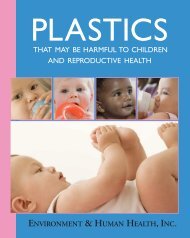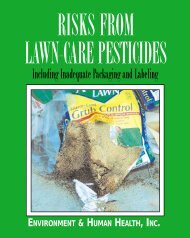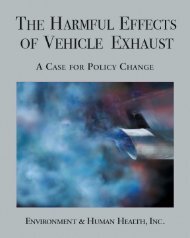LEED Report - Environment & Human Health, Inc.
LEED Report - Environment & Human Health, Inc.
LEED Report - Environment & Human Health, Inc.
- No tags were found...
You also want an ePaper? Increase the reach of your titles
YUMPU automatically turns print PDFs into web optimized ePapers that Google loves.
The Green Building DebateNone of the minimum requirements explicitly addresses the need toreduce chemical exposures or to protect human health. While <strong>LEED</strong>requires compliance with “environmental laws, including all applicablefederal, state, and local building-related regulations,” these laws restrictthe use and concentrations of very few chemicals in indoorenvironments. This is well demonstrated by the presence of manyhazardous chemicals in human tissues, as shown in the additional casestudies that follow.L E E D I n d o o r A i r Q u a l i t y P e r f o r m a n c eThe rating category intended to encourage protection of health is titled,“Indoor <strong>Environment</strong>al Quality.” A building can achieve a total of 15points in the indoor environmental quality category among a possibletotal of 110 from all other rating categories. However, 8 of the 15possible points may be awarded for lighting, daylight and views (3points possible), thermal comfort (3 points possible), and air qualitymanagement planning during construction (2 points possible).Only 7 out of a possible110 points have the primaryintent to limit hazardouschemicals within thebuilt environment.Thus, only 7 out of a possible 110 points have the primary intentto limit hazardous chemicals within the built environment.Since the highest building rating possible onlyrequires a total score of 80 points, <strong>LEED</strong>certification is possible, even at thehighest “platinum” level, withoutearning credits in the indoorair category, the categorymost likely to protecthuman health.13







